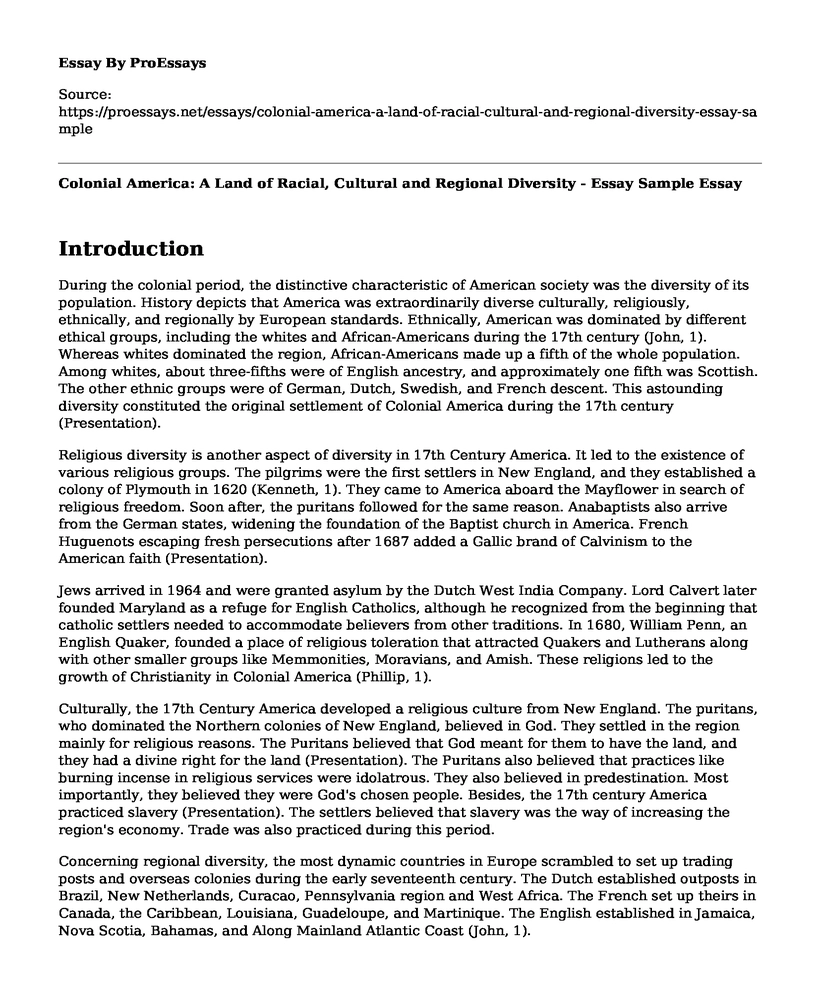Introduction
During the colonial period, the distinctive characteristic of American society was the diversity of its population. History depicts that America was extraordinarily diverse culturally, religiously, ethnically, and regionally by European standards. Ethnically, American was dominated by different ethical groups, including the whites and African-Americans during the 17th century (John, 1). Whereas whites dominated the region, African-Americans made up a fifth of the whole population. Among whites, about three-fifths were of English ancestry, and approximately one fifth was Scottish. The other ethnic groups were of German, Dutch, Swedish, and French descent. This astounding diversity constituted the original settlement of Colonial America during the 17th century (Presentation).
Religious diversity is another aspect of diversity in 17th Century America. It led to the existence of various religious groups. The pilgrims were the first settlers in New England, and they established a colony of Plymouth in 1620 (Kenneth, 1). They came to America aboard the Mayflower in search of religious freedom. Soon after, the puritans followed for the same reason. Anabaptists also arrive from the German states, widening the foundation of the Baptist church in America. French Huguenots escaping fresh persecutions after 1687 added a Gallic brand of Calvinism to the American faith (Presentation).
Jews arrived in 1964 and were granted asylum by the Dutch West India Company. Lord Calvert later founded Maryland as a refuge for English Catholics, although he recognized from the beginning that catholic settlers needed to accommodate believers from other traditions. In 1680, William Penn, an English Quaker, founded a place of religious toleration that attracted Quakers and Lutherans along with other smaller groups like Memmonities, Moravians, and Amish. These religions led to the growth of Christianity in Colonial America (Phillip, 1).
Culturally, the 17th Century America developed a religious culture from New England. The puritans, who dominated the Northern colonies of New England, believed in God. They settled in the region mainly for religious reasons. The Puritans believed that God meant for them to have the land, and they had a divine right for the land (Presentation). The Puritans also believed that practices like burning incense in religious services were idolatrous. They also believed in predestination. Most importantly, they believed they were God's chosen people. Besides, the 17th century America practiced slavery (Presentation). The settlers believed that slavery was the way of increasing the region's economy. Trade was also practiced during this period.
Concerning regional diversity, the most dynamic countries in Europe scrambled to set up trading posts and overseas colonies during the early seventeenth century. The Dutch established outposts in Brazil, New Netherlands, Curacao, Pennsylvania region and West Africa. The French set up theirs in Canada, the Caribbean, Louisiana, Guadeloupe, and Martinique. The English established in Jamaica, Nova Scotia, Bahamas, and Along Mainland Atlantic Coast (John, 1).
Advantages and Disadvantages of Diversity
This diversity was beneficial in the sense that it dispelled negative stereotypes and individual biases regarding different groups. Cultural diversity, for instance, helped in recognizing and respecting other peoples' ways of life. Diversity also promoted interaction, which enabled people to build bridges and understand each other. Diversity also helped in ending slavery that was common during the 17th century America.
Further, diversity strengthened freedom of religion in America. Another importance of diversity is that it increased economies through trade. Different countries could make trade deals, which were essential for economic development. However, the negative side of diversity is that it promoted social tension due to cultural and linguistic differences. Another disadvantage of diversity is that it led to discrimination in some regions. It is worth noting that diversity encouraged people to be identified with their culture, language, region, class, and religion, which resulted in various forms of discrimination
Work Cited
John, Hanc. Smithsonian. 21st November 2016. 13th October 2019 <https://www.smithsonianmag.com/history/why-edward-winslow-plymouth-hero-thanksgiving-180961174/>.
Kenneth, Davis. Smithsonian Magazine. October 2010. 13th October 2019 <https://www.smithsonianmag.com/history/americas-true-history-of-religious-tolerance-61312684/>.
Phillip, Picardi. Teen Vogue. 22nd November 2016. <https://www.teenvogue.com/story/native-american-girls-describe-the-real-history-behind-thanksgiving>.
Cite this page
Colonial America: A Land of Racial, Cultural and Regional Diversity - Essay Sample. (2023, Feb 27). Retrieved from https://proessays.net/essays/colonial-america-a-land-of-racial-cultural-and-regional-diversity-essay-sample
If you are the original author of this essay and no longer wish to have it published on the ProEssays website, please click below to request its removal:
- Genealogy Essay Example
- Japan Aesthetic Essay Example
- Essay on U.S. Enters WWI: Woodrow Wilson's World Safe for Democracy
- Essay Example on Student From Kuwait Adapts to East Asian Education: A Historical Context
- Essay Example on Gender Parity: From Traditions to Equality
- Paper Example on Beauty Pageants: Sites for Cultural Production & Contestation
- Free Paper Sample on Missouri Human Rights Act vs Fair Standard Act







